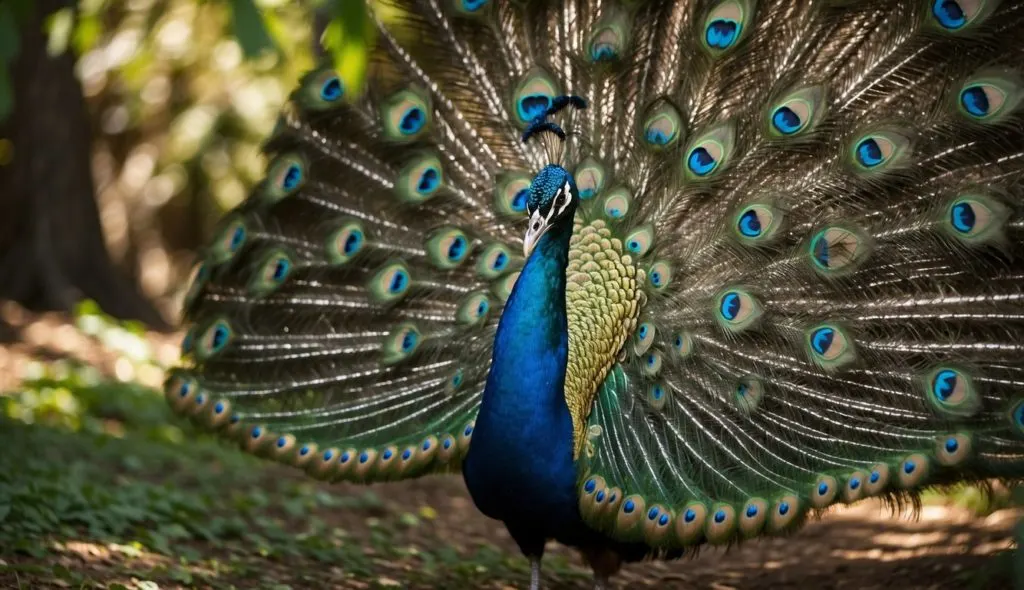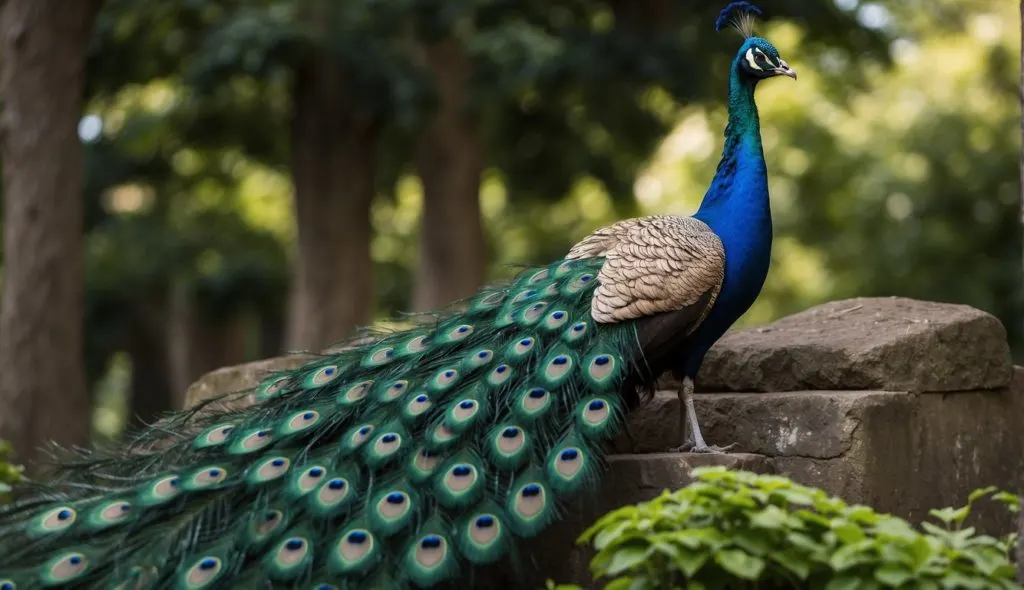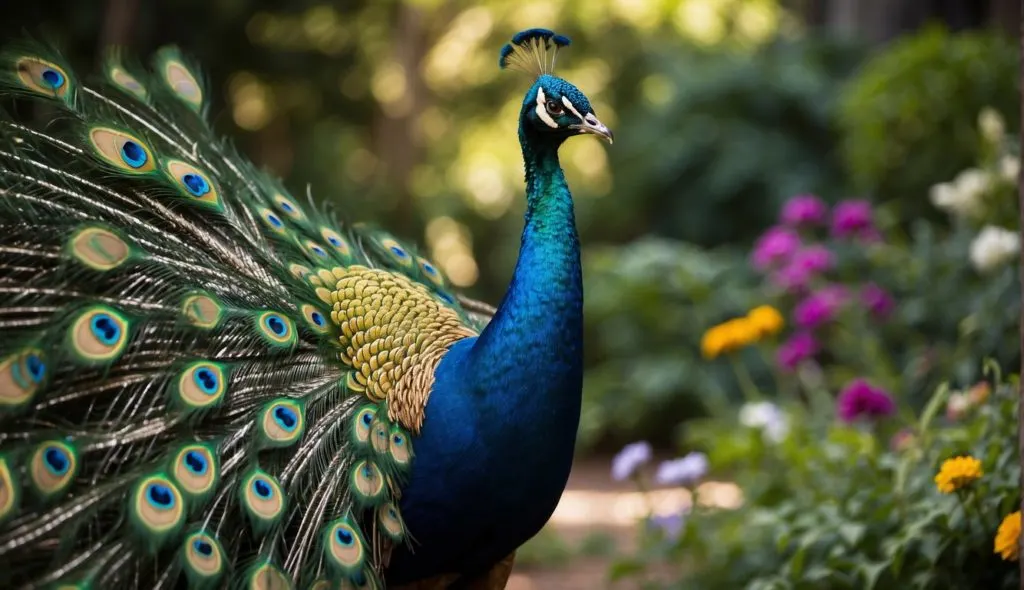For many, many years, one of our neighbors had a peacock. I loved hearing its calls and seeing its amazing feathers — but never realized that the peacock lifespan is just as remarkable as their appearance.

In captivity, peacocks can live for up to 20 years, sometimes even longer! It’s all thanks to a controlled environment that shields them from predators and diseases.
However, in the wild, their lifespan is shorter, typically ranging between 10 to 15 years. This variance is largely due to the challenges they face in their natural habitat, such as predators, diseases, and competition for food and mates.
Consistent access to nutritious food and safe roosting places in captivity greatly extends their life compared to their wild counterparts.
Lifespan Determinants

The lifespan of peacocks can be influenced by various factors including their genetics, the environments they occupy, and the diets they consume.
Genetics and Biology
Your peacock’s lifespan is significantly impacted by its genetic makeup. Peafowl that come from a lineage with inherent longevity are more likely to live longer, assuming other conditions are favorable.
Furthermore, biological factors such as resilience to diseases and rate of aging play a crucial role in determining the lifespan.
Habitat and Environment
The environment you provide for a peacock influences its lifespan. Peacocks thriving in natural, protected habitats tend to live longer than those in captivity or in areas with environmental stressors. Key factors include:
- Shelter: Protection from harsh weather and predators
- Space: Adequate roaming space to encourage natural behaviors
Diet and Nutrition
A balanced diet is vital for a peacock’s health and longevity. They are omnivores, and their diet generally consists of:
- Insects and small reptiles: For protein
- Seeds and plants: For vitamins and minerals
Providing a nutritionally rich diet can help prevent diseases and support a stronger immune system, contributing to a longer life.
Peacock Lifespan in the Wild

Peacocks in the wild generally have a shorter lifespan, influenced by several factors.
Survival Challenges
In the wild, your peacock faces daily survival challenges. The availability of food and water has a direct impact on their lifespan.
During periods of scarcity, they may suffer from malnutrition which can reduce life expectancy.
- Food Scarcity: Lack of food leads to malnutrition.
- Water Scarcity: Limited access to clean water sources.
Natural Predators
Peacocks must be vigilant to evade predators. Key natural predators include:
- Big Cats: Leopards, tigers, and jungle cats are all peacock predators in their native Asian habitats. In areas where peafowls have been introduced, other large carnivores might prey on them.
- Birds of Prey: Eagles and hawks may target young and smaller peacocks.
- Wild Dogs: Packs can overpower an adult peacock.
- Mongoose: Mongooses are known to raid nests and can kill adult peafowls.
- Snakes: Large snakes pose a threat to eggs and juvenile peafowls.
Peafowls have various adaptations to deal with these threats, including their loud calls to signal danger and their ability to fly up into trees to escape ground-based predators. Despite their vibrant plumage, which one might assume makes them easy targets, they are quite adept at evading predators when necessary.
Disease and Injuries
A peacock’s life can be cut short by diseases and injuries. Common issues are:
- Parasites: Can lead to debilitating diseases.
- Bacterial Infections: May result from injuries.
- Broken Limbs: Can occur due to falls or predator attacks, hindering the peacock’s ability to survive.
Peacock Lifespan in Captivity
Peacocks typically live longer in captivity than in the wild due to improved care and monitored environments. Your understanding of their lifespan in controlled conditions will help you appreciate these magnificent birds.
Care and Management
When you maintain a suitable habitat and a nutritious diet, peacocks in captivity can thrive, with life expectancies often reaching 20 years or more. Key components of care include:
- Shelter: A spacious, clean, and safe environment protects them from predators and harsh weather.
- Diet: A balanced diet rich in vitamins and minerals supports their health and longevity.
Veterinary Support
Regular veterinary check-ups are crucial for your peacocks. These visits help prevent, diagnose, and treat potential health issues that might otherwise shorten their lifespan. Veterinary support includes:
- Vaccinations: Protect against common avian diseases.
- Parasite Control: Regular deworming and pest management keep peacocks at prime health.
Breeding Programs
Managed breeding programs contribute to extended lifespans by ensuring genetic diversity and preventing inbreeding-related health problems. If you’re part of a breeding program, you’ll find that:
- Record Keeping: Tracking lineage and health records to support optimal breeding outcomes.
- Partner Selection: Careful matching of breeding pairs to improve genetic variety and vitality.
FAQs
Do male and female peacocks have different lifespans?
Generally, both peahens (females) and peacocks (males) have similar lifespans, although some data suggests that peahens may live slightly longer, likely due to not having the risks associated with displaying and mating behaviors.
Can peacocks live longer in zoos? Why?
Yes, peacocks often live longer in well-maintained zoos because they receive balanced diets, protection from predators, and regular veterinary care, which reduces the risk of disease and injury.
- 8 Letter Bird Names - August 14, 2024
- 7 Letter Bird Names - August 14, 2024
- 7 Birds Named After Famous People - July 23, 2024
